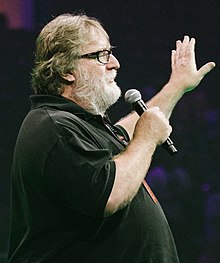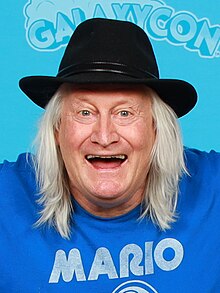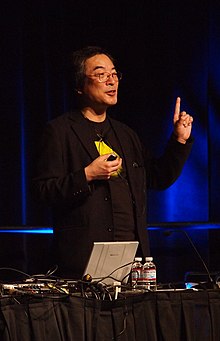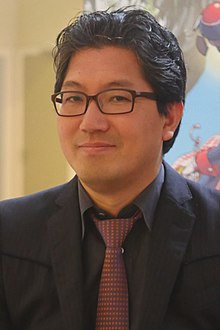Portal:Video games
The Video Games Portal

A video game or computer game is an electronic game that involves interaction with a user interface or input device (such as a joystick, controller, keyboard, or motion sensing device) to generate visual feedback from a display device, most commonly shown in a video format on a television set, computer monitor, flat-panel display or touchscreen on handheld devices, or a virtual reality headset. Most modern video games are audiovisual, with audio complement delivered through speakers or headphones, and sometimes also with other types of sensory feedback (e.g., haptic technology that provides tactile sensations). Some video games also allow microphone and webcam inputs for in-game chatting and livestreaming.
Video games are typically categorized according to their hardware platform, which traditionally includes arcade video games, console games, and computer (PC) games; the latter also encompasses LAN games, online games, and browser games. More recently, the video game industry has expanded onto mobile gaming through mobile devices (such as smartphones and tablet computers), virtual and augmented reality systems, and remote cloud gaming. Video games are also classified into a wide range of genres based on their style of gameplay and target audience. (Full article...)
Featured articles –
The original game, developed between 1977 and 1979 at the Massachusetts Institute of Technology (MIT), was inspired by Colossal Cave Adventure (1976), the first well-known example of interactive fiction and the first well-known adventure game. The developers wanted to make a similar game that was able to understand more complicated sentences than Adventure's two-word commands. In 1979, they founded Infocom with several other colleagues at the MIT computer center. Blank and Joel Berez created a way to run a smaller portion of Zork on several brands of microcomputer, letting them commercialize the game as Infocom's first products. The first episode was published by Personal Software in 1980, after which Infocom purchased back the rights and self-published all three episodes beginning in late 1981.
Zork was a massive success for Infocom, with sales increasing for years as the market for personal computers expanded. The first episode sold more than 38,000 copies in 1982, and around 150,000 copies in 1984. Collectively, the three episodes sold more than 680,000 copies through 1986, comprising more than one-third of Infocom's sales in this period. Infocom was purchased by Activision in 1986, leading to new Zork games beginning in 1987, as well as a series of books. Reviews of the episodes were very positive, several reviewers calling Zork the best adventure game to date. Critics regard it as one of the greatest video games. Later historians have noted the game as foundational to the adventure game genre, as well as influencing the MUD and massively multiplayer online role-playing game genres. In 2007, Zork was included in the game canon by the Library of Congress as one of the ten most important video games in history. (Full article...)
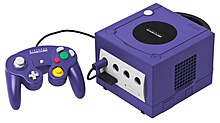
The Capcom Five are five video games that were unveiled by Capcom in late 2002 and published from March 2003. At a time when Nintendo's GameCube console had failed to capture market share, Capcom announced five new GameCube titles with the apparent goal of boosting hardware sales and demonstrating third-party developer support. Capcom USA followed up with confirmation that they would be exclusive to the GameCube. The five games were P.N.03, a futuristic third-person shooter; Viewtiful Joe, a side-scrolling action-platformer; Dead Phoenix, a shoot 'em up; Resident Evil 4, a survival horror third-person shooter; and Killer7, an action-adventure game with first-person shooter elements. Though not directly related to each other, they were all overseen by Resident Evil director Shinji Mikami and, except Killer7, developed by Capcom's Production Studio 4. Capcom USA later clarified that only Resident Evil 4 was intended to be exclusive; the initial announcement was due to a miscommunication with their parent company.
Of the five games, Dead Phoenix was canceled and only P.N.03 remained a GameCube exclusive. P.N.03 received mixed reviews and was a commercial failure, but is now considered a "cult classic". Both Viewtiful Joe and Killer7 sold modestly, the former despite critical acclaim and the latter owing to polarized reviews. Killer7 gained a significant cult following, effectively launching the career of director Suda51. Resident Evil 4 was the runaway success of the five, though its GameCube sales were undercut by the announcement of a PlayStation 2 port to be released later in 2005. Viewtiful Joe also saw a PlayStation 2 version with expanded features, and Killer7 debuted on multiple platforms simultaneously. Since the release of the Nintendo 64, Nintendo struggled to attract third-party developers like Capcom to produce games for its systems. Industry analysts see the Capcom Five case, particularly the loss of GameCube exclusivity for Resident Evil 4, as a major blow to Nintendo–Capcom relations and is emblematic of Nintendo's failure to attract third-party support during the GameCube era. (Full article...)
Programmer Ed Salvo was inspired to make Lost Luggage when he was waiting for his luggage at the Dallas/Fort Worth International Airport, and the game took around four weeks to produce. Reviewers criticized the game's similarity to Activision's Kaboom!—which itself is based on the arcade game Avalanche—believing Lost Luggage to be an inferior clone. (Full article...)
Set in a retro-futuristic version of 1988, the story follows a ninja named Ryu Hayabusa as he journeys to America to avenge his murdered father. There, he learns that a person named "the Jaquio" plans to take control of the world by unleashing an ancient demon through the power contained in two statues. Featuring side-scrolling platform gameplay similar to Castlevania, players control Ryu through six "Acts" that comprise 20 levels; they encounter enemies that must be dispatched with Ryu's katana and other secondary weapons.
Ninja Gaiden has an elaborate story told through anime-like cinematic cutscenes. It received extensive coverage and won several awards from video gaming magazines, while criticism focused on its high difficulty, particularly in the later levels. Director Hideo Yoshizawa named Ninja Gaiden as his most commercially successful project. The game continued to receive acclaim from print and online publications, being cited as one of the greatest video games of all time. It was novelized as part of the Worlds of Power game adaptations written by Seth Godin and Peter Lerangis. The game was followed by Ninja Gaiden II: The Dark Sword of Chaos (1990) and Ninja Gaiden III: The Ancient Ship of Doom (1991). A manga-styled comic book, Ninja Gaiden '88, published by Dark Horse Comics, continued the narrative of the five original games. (Full article...)
Power Tennis incorporates multiple characters, themes, and locations from the Mario series. The game includes standard tennis matches, but contains variants that feature different scoring formats and objectives. Other variants include "Gimmick" courts, thematic areas with components and properties that directly affect gameplay. The game has 18 playable characters, each categorised by their style of play and each with a pair of unique moves known as "Power Shots". Power Tennis was developed simultaneously with Mario Golf: Toadstool Tour, and the pair shared similar technology and concepts with each other during production. Such similarities include an emphasis on the Mario theme in characters and settings as well as alternative game modes such as "Ring Shot".
The GameCube version was positively received in general, attaining an aggregate score of 81 percent from GameRankings and 80 out of 100 from Metacritic. Critics praised the game's depth and variety, but criticised the Power Shot animations, which could not be skipped. The Wii version in contrast received a more mixed reaction, with praise for the graphics and multiplayer but criticism for its motion controls. In 2010, it was included as one of the games in the book 1001 Video Games You Must Play Before You Die. (Full article...)
Populous: The Beginning was the first entry in the series to use 3D computer graphics; Bullfrog waited four years after Populous II: Trials of the Olympian Gods so that the graphics technology could catch up to their vision for a new and different game in the series. The developers considered the addition of terrain deformation and manipulation, combined with "smart" villagers who automatically attended to tasks, to add an entirely new dimension to the series. The game's original title was Populous: The Third Coming before being changed prior to the beta release.
Populous: The Beginning plays very differently from earlier titles and received mixed reviews. Critics noted the excellent graphics, while complaints were directed at the artificial intelligence and the indecision in game design between being a real time strategy title and a god game. GamePro's Peter Olafson wrote that Populous: The Beginning was a good game but was "without a quintessential quality that defined Populous." (Full article...)
The gameplay is similar to previous installments, focusing on combo-based combat with the player's main weapon, the Blades of Chaos, and other weapons acquired by the game's World Weapons mechanic. It continues the use of quick time events from previous entries but also utilizes a promptless free-form system. Four magical attacks and a power-enhancing ability can be used as alternative combat options, and the game features puzzles and platforming elements. The game also features a redesigned combat system, gameplay mechanics not available in previous installments, and downloadable content. Notably, Ascension is the only installment in the series to include multiplayer, which is online-only and features modes for both competitive and cooperative play. From October 2012 to March 2013, a social experience was available online in the form of a graphic novel titled Rise of the Warrior, a prequel story that tied into the game's single-player and multiplayer modes. Ascension was the last game in the series (production-wise; chronologically it was God of War III) to be based on Greek mythology and also the last one to feature Terrence C. Carson as the voice of Kratos as the franchise shifted to Norse mythology with 2018's God of War and Christopher Judge took over the role of Kratos.
God of War: Ascension received generally favorable reviews from critics, who praised its fundamental gameplay and spectacle as true to the series, although the story was deemed to be less compelling than in previous installments. The game's multiplayer element received mixed responses: although reviewers found that the gameplay translated well into the multiplayer setting, they criticized the balance and depth of combat. Ascension sold less well than its predecessor, with only 3 million copies sold and received no awards, but it did however, receive several nominations, including "Outstanding Achievement in Videogame Writing" at the Writers Guild of America Videogame Awards and the Academy of Interactive Arts & Sciences award for "Outstanding Achievement in Sound Design". (Full article...)
The game takes place in the fictional floating world of Cocoon, whose government, the Sanctum, is ordering a purge of civilians who have supposedly come into contact with Pulse, the much-feared world below. The former soldier Lightning begins her fight against the government in order to save her sister who has been branded as an unwilling servant to a god-like being from Pulse, making her an enemy of Cocoon. Lightning is soon joined by a band of allies, and together the group also become marked by the same Pulse creature. They rally against the Sanctum while trying to discover their assigned task and whether they can avoid being turned into monsters or crystals at the completion.
Development began in 2004, and the game was first announced at Electronic Entertainment Expo (E3) 2006. Final Fantasy XIII is the flagship title of the Fabula Nova Crystallis collection of Final Fantasy games and is the first game to use Square Enix's Crystal Tools engine. Final Fantasy XIII was critically acclaimed in Japan and received mostly positive reviews from Western video game publications, which praised the game's graphics, presentation, and battle system. The game’s linearity received a more mixed reception from some critics. Selling 1.7 million copies in Japan in 2009, Final Fantasy XIII became the fastest-selling title in the history of the series. As of 2017, the game has sold over 7 million copies worldwide on consoles. The Windows version has sold over 746,000 copies according to SteamSpy. A sequel, titled Final Fantasy XIII-2, was released in December 2011 in Japan and in February 2012 in North America and PAL regions. A second sequel, titled Lightning Returns: Final Fantasy XIII, which concludes Lightning's story and the Final Fantasy XIII series, was released in November 2013 in Japan and in February 2014 in North America and PAL regions. As of September 2014, the Final Fantasy XIII series has shipped over 11 million copies worldwide. (Full article...)
Did you know... -
- ... that the name of the video game mod series Bomba Patch was inspired by éclairs?
- ... that Elena from the video game series Street Fighter uses a capoeira fighting style, for which the development team used travel videos as reference material as they had no experience with the style?
- ... that LittleBigPlanet, a video game that allows the player to create levels, coincided with the rise of user-generated content?
- ... that deceased YouTuber Technoblade beat the video game Minecraft in hardcore mode using a racing-wheel controller?
- ... that Tetris Holding won an injunction in 2012 to stop sales of a video game clone of their famed Tetris game?
- ... that Paul Dini was a writer for both the animated television series Batman: The Animated Series and the video game series Batman: Arkham?
- ... that the music for the video game Rings of Power was composed by a first-year medical student?
- ... that the 1999 video game Interplay Sports Baseball Edition 2000 used a public-address announcer while its rivals were switching to two commentators as featured on real MLB game broadcasts?
- ... that the success of Kingdom Rush prompted plans to grow the video game industry of Uruguay?
- ... that a reviewer thought that the video game Robbery Bob contained cringeworthy dialogue?
- ... that a cheat code in the video game Spyro: Year of the Dragon grants access to a near-complete copy of Crash Bash?
- ... that the graffiti artists hired for the video game Skitchin' were interviewed at a train station because they were too young to drive?
Selected biography –
Selected image -

- May 24, 2024 – Uvalde school shooting
- Families in Uvalde, Texas, U.S., file a lawsuit against Daniel Defense and Activision Blizzard for creating the DDM4 V7 gun and promoting the weapon through the game Call of Duty, respectively. They also sue Meta Platforms for owning Instagram, which was used by the gunman. (AP)
- April 16, 2024 – 2023–2024 video game industry layoffs
- American video game company Take-Two Interactive lays off 5% of its workforce. (Reuters)
- April 10, 2024 – 2023–2024 video game industry layoffs
- American video game company Epic Games announces that it will lay-off around 870 employees, roughly one-sixth of its workforce, due to slower growth than expected. (CBC via Yahoo! News)
Topics
Categories
Things you can do
In other Wikimedia projects
The following Wikimedia Foundation sister projects provide more on this subject:
-
Commons
Free media repository -
Wikibooks
Free textbooks and manuals -
Wikidata
Free knowledge base -
Wikinews
Free-content news -
Wikiquote
Collection of quotations -
Wikisource
Free-content library -
Wikiversity
Free learning tools -
Wiktionary
Dictionary and thesaurus


